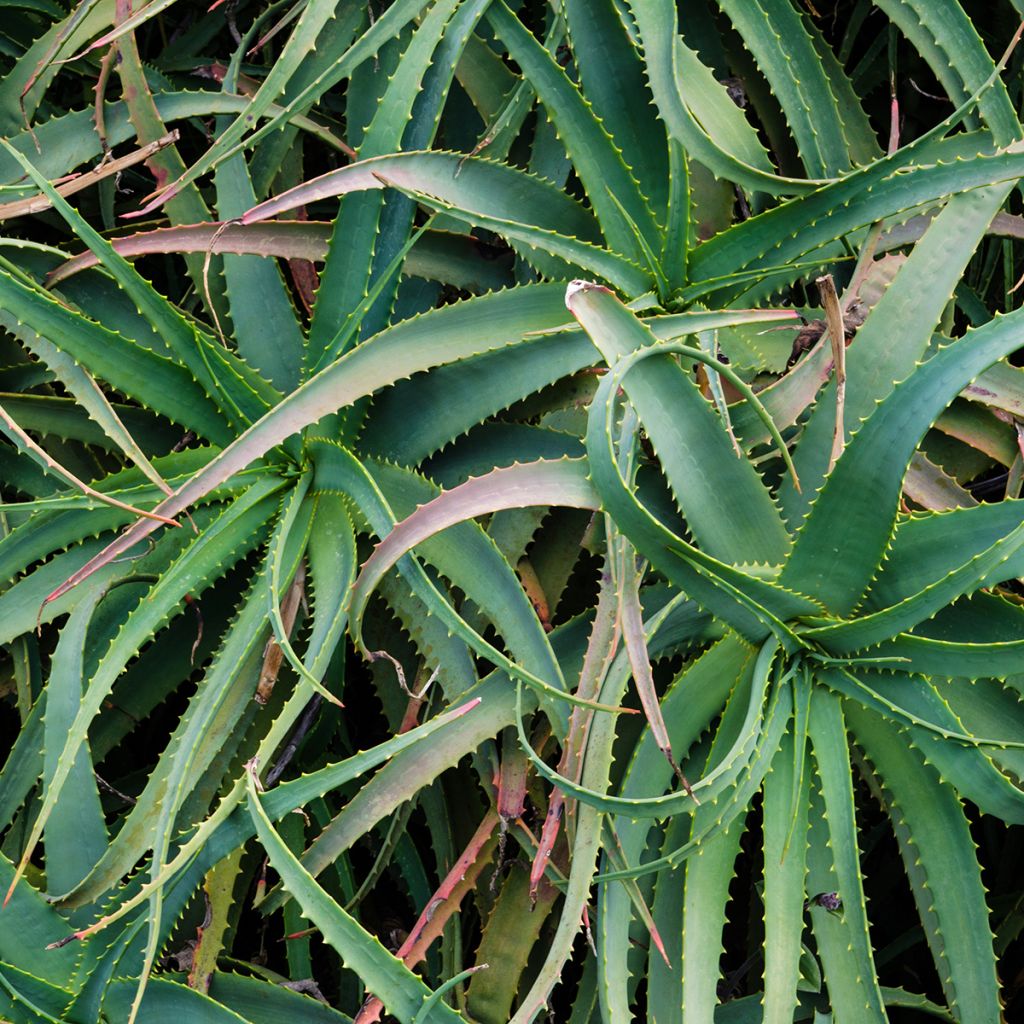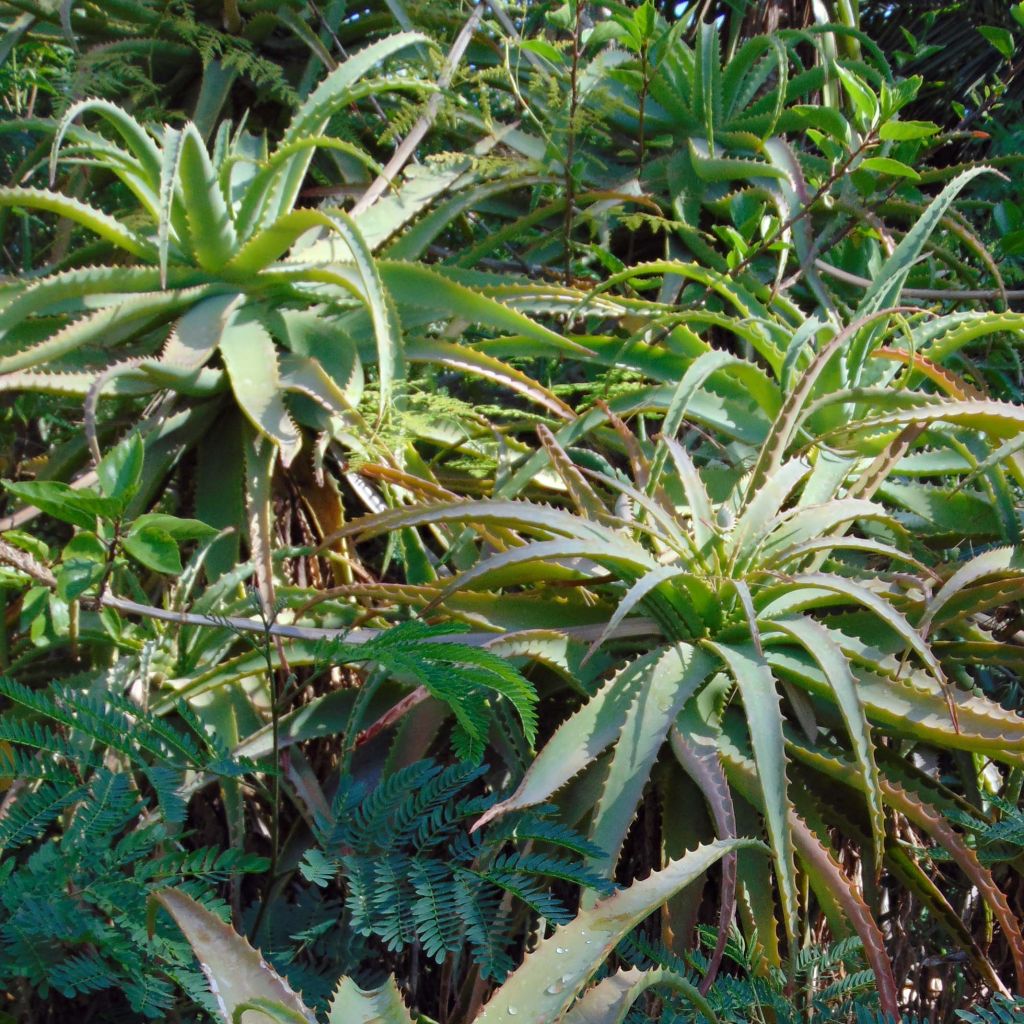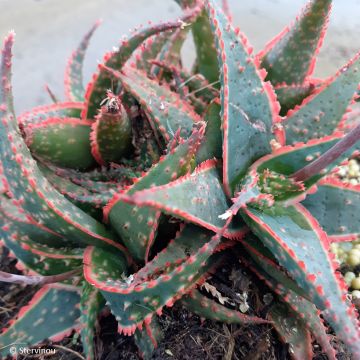

Aloe arborescens


Aloe arborescens


Aloe arborescens


Aloe arborescens


Aloe arborescens


Aloe arborescens


Aloe arborescens


Aloe arborescens


Aloe arborescens
Aloe arborescens
Aloe arborescens
Candelabra Aloe, Krantz Aloe, Tree Aloe
A package with a few necks, a rose bush, in perfect condition, an ideal young plant to be repotted or transplanted. Only the Aloe, of a beautiful size, has traveled poorly, probably upside down, moreover. I have the impression, based on the comments, that this is inevitable and that it is necessary to develop a treasure trove of engineering to ensure that this plant arrives in good condition or simply sell it at a smaller size. After that, I believe that in one season, it will regain its splendor. Meanwhile, the Aloe striatula travels much better, probably less fragile.
Baptiste, 16/10/2021
Special offer!
Receive a €20 voucher for any order over €90 (excluding delivery costs, credit notes, and plastic-free options)!
1- Add your favorite plants to your cart.
2- Once you have reached €90, confirm your order (you can even choose the delivery date!).
3- As soon as your order is shipped, you will receive an email containing your voucher code, valid for 3 months (90 days).
Your voucher is unique and can only be used once, for any order with a minimum value of €20, excluding delivery costs.
Can be combined with other current offers, non-divisible and non-refundable.
Home or relay delivery (depending on size and destination)
Schedule delivery date,
and select date in basket
This plant carries a 12 months recovery warranty
More information
We guarantee the quality of our plants for a full growing cycle, and will replace at our expense any plant that fails to recover under normal climatic and planting conditions.
Would this plant suit my garden?
Set up your Plantfit profile →
Description
Arborescent Aloe, also known as Tree Aloe or Candelabra Aloe, is a beautiful botanical species, though not a hardy one. It is capable of forming, in the space of 3 or 4 years, a large and unusual spreading bush, resembliing a scaffolding of rosettes of long, tentacle-like dentate leaves, carried at the end of thick stems. This plant is well-known for its medicinal properties which, according to recent studies, seem to be even more powerful than those of its famous cousin, Aloe vera. Its unusual and surprising flowering can take place as early as the end of winter. From the centre of the rosettes emerge spikes of red flowers, very decorative, somewhat reminiscent of tritoma flowers. Its cultivation presents no difficulty in well-drained soil: adopt this wonderful and miraculous plant in a large pot on the terrace, and bring it indoors to protect it from frost in winter!
The Arborescent Aloe, sometimes called Deer Horn or Ram's Horn, is a botanical species in the family Aloeaceae, native to southeastern South Africa. Its range is wide, extending to Botswana, Malawi, Mozambique, and Zimbabwe. This plant grows on mountain cliffs, in high-altitude meadows, anchored to rocks, in open forests, and along wooded coastlines. It has become invasive in Portugal and has naturalised in the south of France. It is a large plant, more bushy than perennial, with succulent and evergreen foliage. It forms a large bush with an open habit, with thick semi-erect branches that spread more or less on the ground. Its growth is very rapid. An adult plant will reach about 3m (9 ft 10 in) in height and an approximate spread of 2m 50cm (8 ft 2 in), or even more, under good growing conditions. The branches originate from the base and taper into stems that give rise to clusters of long, thick, waxy leaves, with a matte bluish-green color, often concave, sword-shaped, 40 to 60cm (15.7 - 23.6 in) long and edged with small teeth. In March-April rosettes of tall, branched flower stems emerge, bearing 30cm (11.8 in) long spikes composed of tubular red flowers, popular with pollinating insects. The flower spike moves away from the centre as new leaves appear. Arborescent Aloe produces many new stems when well-pruned, a trait that can be used to shape it into a beautiful dome shape, particularly ornamental when the plant is in bloom. Conversely, if young shoots are regularly removed from the base, it can be trained into a small tree.
Highly resistant to sea spray and drought, preferring to grow in stone walls that isolate it from moisture, Arborescent Aloe is most often cultivated in pots to decorate a terrace or balcony due to its low hardiness (down to -4°C). Planting in the ground should be reserved for regions completely spared from frost. To enjoy its unusual silhouette, install in an elevated rocky bed overlooking a path or garage driveway, in a rock garden or on a dry slope. It makes a magnificent specimen in well-drained and sloping or rocky terrain, or even anchored to dry stone walls. Elsewhere, it can be planted in a pot taller than it is wide (as it multiplies quickly) to showcase its strong personality on a contemporary or exotic-themed terrace. It combines well with agaves, prickly pears, Delosperma, Carpobrotus, or shrubby Euphorbias (Euphorbia mellifera). At their base, you can plant frugal ground covers: Evening Primroses, Osteospermums, Felicia, or witch claws, which will fill the space with their flowering and persistent foliage, hiding any gaps left by dead plants.
The therapeutic properties of Arborescent Aloe are currently being studied. This plant was used more commonly in traditional Asian or Mediterranean pharmacopoeia than in South Africa. In Japan, the leaves are consumed as a purgative. The gel, similar to that of Aloe vera, is used in dermatology and cosmetology. At the end of World War II, the gel of Arborescent Aloe helped heal the burns of Hiroshima victims, further establishing knowledge of the exceptional healing properties of this plant. The leaves are only harvested from the third year of cultivation onwards.
About Agaves and Aloes:
Aloes and agaves resemble each other but belong to two different botanical families, Aloeaceae and Agavaceae. The main difference lies in the fact that the rosettes of aloes flower for many years, while the flowering of a mature agave rosette marks the end of its life. In some Aloe species, interfoliar buds give rise to new plants that cover the dried-out remains of the mother plant. In agaves, the central flower spike develops from the terminal bud. In aloes, the flower buds emerge between the leaves. Agaves are native to North America, while aloes are found only in the southern half of Africa, as well as in nearby Indian Ocean islands.
Report an error about the product description
Aloe arborescens in pictures






Flowering
Foliage
Plant habit
Botanical data
Aloe
arborescens
Aloeaceae
Candelabra Aloe, Krantz Aloe, Tree Aloe
South Africa
Other Aloe
View all →Planting and care
Like all "succulent" plants, aloes generally prefer full sun and very well-drained, even arid soil. Aloe arborescens appreciates very rocky, gravelly or sandy soils, even poor ones, and is tolerant of limestone in the soil. The hardiness of this plant depends a lot on the soil drainage, which should not retain moisture in winter, but it will not withstand temperatures of -4°C (24.8 °F) or below. Easy to grow in a dry and sunny rockery, a gravel-enriched flowerbed, or in large pots. Its resistance to summer drought is excellent. It tolerates winter pruning well, which allows it to develop a nice dome-shaped habit.
Substrate for pot cultivation: 3/4 potting soil + 1/4 topsoil + organic fertiliser.
In a greenhouse, watch out for attacks from mealybugs.
Propagation: by cuttings of shoots formed at the base of the plant or rosettes.
Planting period
Intended location
Care
-
, onOrder confirmed
Reply from on Promesse de fleurs
Similar products
Haven't found what you were looking for?
Hardiness is the lowest winter temperature a plant can endure without suffering serious damage or even dying. However, hardiness is affected by location (a sheltered area, such as a patio), protection (winter cover) and soil type (hardiness is improved by well-drained soil).

Photo Sharing Terms & Conditions
In order to encourage gardeners to interact and share their experiences, Promesse de fleurs offers various media enabling content to be uploaded onto its Site - in particular via the ‘Photo sharing’ module.
The User agrees to refrain from:
- Posting any content that is illegal, prejudicial, insulting, racist, inciteful to hatred, revisionist, contrary to public decency, that infringes on privacy or on the privacy rights of third parties, in particular the publicity rights of persons and goods, intellectual property rights, or the right to privacy.
- Submitting content on behalf of a third party;
- Impersonate the identity of a third party and/or publish any personal information about a third party;
In general, the User undertakes to refrain from any unethical behaviour.
All Content (in particular text, comments, files, images, photos, videos, creative works, etc.), which may be subject to property or intellectual property rights, image or other private rights, shall remain the property of the User, subject to the limited rights granted by the terms of the licence granted by Promesse de fleurs as stated below. Users are at liberty to publish or not to publish such Content on the Site, notably via the ‘Photo Sharing’ facility, and accept that this Content shall be made public and freely accessible, notably on the Internet.
Users further acknowledge, undertake to have ,and guarantee that they hold all necessary rights and permissions to publish such material on the Site, in particular with regard to the legislation in force pertaining to any privacy, property, intellectual property, image, or contractual rights, or rights of any other nature. By publishing such Content on the Site, Users acknowledge accepting full liability as publishers of the Content within the meaning of the law, and grant Promesse de fleurs, free of charge, an inclusive, worldwide licence for the said Content for the entire duration of its publication, including all reproduction, representation, up/downloading, displaying, performing, transmission, and storage rights.
Users also grant permission for their name to be linked to the Content and accept that this link may not always be made available.
By engaging in posting material, Users consent to their Content becoming automatically accessible on the Internet, in particular on other sites and/or blogs and/or web pages of the Promesse de fleurs site, including in particular social pages and the Promesse de fleurs catalogue.
Users may secure the removal of entrusted content free of charge by issuing a simple request via our contact form.
The flowering period indicated on our website applies to countries and regions located in USDA zone 8 (France, the United Kingdom, Ireland, the Netherlands, etc.)
It will vary according to where you live:
- In zones 9 to 10 (Italy, Spain, Greece, etc.), flowering will occur about 2 to 4 weeks earlier.
- In zones 6 to 7 (Germany, Poland, Slovenia, and lower mountainous regions), flowering will be delayed by 2 to 3 weeks.
- In zone 5 (Central Europe, Scandinavia), blooming will be delayed by 3 to 5 weeks.
In temperate climates, pruning of spring-flowering shrubs (forsythia, spireas, etc.) should be done just after flowering.
Pruning of summer-flowering shrubs (Indian Lilac, Perovskia, etc.) can be done in winter or spring.
In cold regions as well as with frost-sensitive plants, avoid pruning too early when severe frosts may still occur.
The planting period indicated on our website applies to countries and regions located in USDA zone 8 (France, United Kingdom, Ireland, Netherlands).
It will vary according to where you live:
- In Mediterranean zones (Marseille, Madrid, Milan, etc.), autumn and winter are the best planting periods.
- In continental zones (Strasbourg, Munich, Vienna, etc.), delay planting by 2 to 3 weeks in spring and bring it forward by 2 to 4 weeks in autumn.
- In mountainous regions (the Alps, Pyrenees, Carpathians, etc.), it is best to plant in late spring (May-June) or late summer (August-September).
The harvesting period indicated on our website applies to countries and regions in USDA zone 8 (France, England, Ireland, the Netherlands).
In colder areas (Scandinavia, Poland, Austria...) fruit and vegetable harvests are likely to be delayed by 3-4 weeks.
In warmer areas (Italy, Spain, Greece, etc.), harvesting will probably take place earlier, depending on weather conditions.
The sowing periods indicated on our website apply to countries and regions within USDA Zone 8 (France, UK, Ireland, Netherlands).
In colder areas (Scandinavia, Poland, Austria...), delay any outdoor sowing by 3-4 weeks, or sow under glass.
In warmer climes (Italy, Spain, Greece, etc.), bring outdoor sowing forward by a few weeks.



















































